Creating a startup is oodles of fun.
Your heart thumps with emotion when you think about your business model, and your mind spins thinking about all the future possibilities. But reality sets in once you start to market your product.
There’s nothing more painful than realizing you have created something awesome, but you can’t seem to make anyone look at you, or worse, care. And then you have to pull yourself back together to figure out what went wrong.
While startup emergencies often show up once a company begins to heavily invest in marketing, the problem is typically not the marketing itself.
The problem is flawed branding.
Branding Must-Haves: Why Marketing Matters
One of the biggest missteps, among many, in early startup development is going only skin-deep on developing a brand, only to have to go back to square one after marketing efforts tank.
It’s painful watching a startup produce flimsy visual design and hollow copy in their campaigns, as the company gets passed over because a competitor is already out there doing it all much, much better. Ad dollars go down the drain, and everyone is panicking.
These waves of panic often occur after a string of horribly low-ROI campaigns, which force you to realize that you need to improve your brand, or your ship is going to sink. The reason is that you simply can’t market a product successfully without what we call a strong brand identity system.
Done right, your brand identity system can be a money-making monster. It’s capable of stirring the emotions of crowds of fans. Leave it to chance, and you’ll likely hit that brick wall of marketing failure.
But you can do something about it now, long before your marketing tanks. So what should you do early on to avoid wasted ad revenue, lackluster marketing, and sleepless nights?
Here are some branding lessons to embrace right from the start.
It’s Not All About the Logo
Overwhelmed startup founders have the natural tendency to focus on a brand’s tangible assets: logos, color, typography because they’re easy to understand. If you put your logo everywhere, it’s branded, right? I guess, but that doesn’t explain why your last marketing campaign flopped like the Kendall Jenner Pepsi ad (sorry Pepsi, but whoa boy, tone-deaf).
My agency defines a brand identity system as a long-term, permanent marketing tool that dictates your short-term marketing campaigns.
Control and consistency are the names of the game. Just as you can create visual guidelines that address color and typography, so can you create emotional guidelines for writing copy, campaigns, and social media.
Startups often forgo building a brand identity system in favor of diving headfirst into marketing. Marketing is sexy. It’s tangible. It also has the ability to utterly wreck you if you’re not fully prepared to master it.
In fact, startups rarely address developing a brand identity system in their first iterations, because they often haven’t felt that punch of failed marketing yet. They only tackle developing a stronger brand when it’s a dire need, and by then it’s much more difficult.
There’s a better way to make it out of these beginning stages armed with the right mindset to skyrocket you toward strong marketing and even stronger customer retention.
READ MORE: How to Build a Profitable Marketing Strategy
Get Right With Your Purpose to Influence More People
Great brands have a purpose.
They make promises, then keep them. As a result, they influence the scores of customers. Crappy brands float around without point or purpose. They influence no one.
The biggest mistake we see new startups make is that they don’t iterate their products and find their point and purpose fast enough. Too often we see startups dive into marketing with faulty business models, a lack of clarity of the product they’re developing, and zero ideas about who their customer actually is. While some of those factors are just part of flying headfirst into business development, if you’re struggling to get right with your purpose, your customers will never fall madly in love with you.
How do you find your purpose? How do you make, and keep promises?
By answering one simple question: “What’s the special thing only YOU can do that your customers will miss out on if you never existed?”
That, right there, is your purpose for being. Develop that.
Whether it’s disrupting an entire industry or finally being the only option on the block giving real customer service. Whatever it is, make it what you’re known for. Deliver that as a promise in everything you do. Promise your customers that they can rely on you to fulfill your purpose. Build on their trust.
Some of you might have just realized that I pinpointed a major problem for your own startup. Don’t panic, you’re in great company. Incredible business owners and household name brands have made it out of this phase. They developed brands that promised to deliver on their reason for existing.
And the best part? You consume these brands every day and don’t even realize promises are being made and kept. It’s completely natural. It doesn’t feel cheesy, and it’s all authentic. That’s the signature of a well-developed brand system and purposeful marketing.
Do it right and no one even notices that you’re doing it.
Example Time!
Apple
Apple promises to keep delivering innovative tech that disrupts industries. They deliver on that promise in unique, (and sometimes baffling) ways. It’s no accident that a massive number of people have iPhones practically glued to their hands, with ears that perk up when they hear about the next product drop.
Airbnb
Airbnb promises to deliver “living like a local” wherever you travel. They’ve leveraged a nearly untapped gap in the hotel industry: a taste of real life. They even evolved that promise of authenticity by offering curated “locals-only” experiences. Want to surf in California with a pro? Go dancing in Brazil with a world-class Samba instructor? They’re on it. That’s why 150 million users are registered on Airbnb, and it averages 500,000 stays per night.
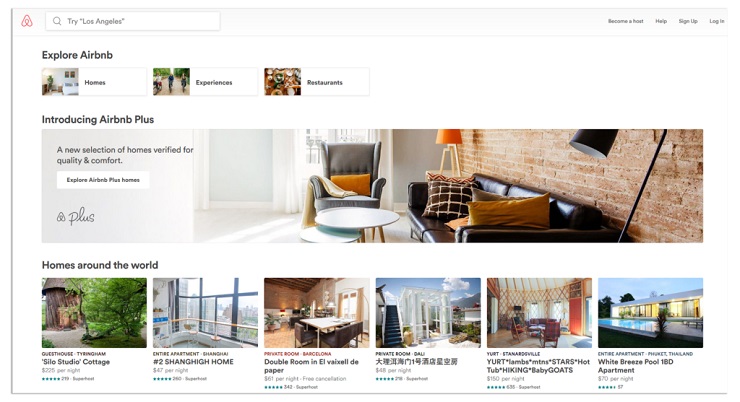
Target
Target’s brand promises to provide fashion and lifestyle items that feel upscale at affordable prices. They keep up with the latest trends, curate shopping experiences in stores to introduce you to new items you gotta have, and bring on major designer names to produce exclusive apparel. Ever leave Target with a purchase of less than $10? Probably not.
You go to Target to have Target tell YOU what to buy!
With a strong sense of purpose, anything is possible. But if you’re floundering to nail down why you even exist, your brand (and subsequently, your marketing), will reflect how confused and uncertain you are.
Now that you know about it, don’t let it happen.
Create a Real Voice and Tone
What is “voice and tone”? Why do you care? How does it make you money?
Just like creating visual guidelines for your logo, colors, and typography, your brand system needs emotional guidelines. How your brand treats people in the written and spoken word can make or break you. That’s where voice and tone come in.
Here’s how we define them, in plain English.
Voice: Your company’s overall verbal persona and attitude.
Tone: How your company’s persona adapts to speaking in specific situations, to groups of people or in special scenarios.
Your voice guides your tone, your tone considers who it’s addressing. Here’s an illustration of how this works:
If your grandmother called you tomorrow needing your help with a computer problem, how would you talk to her? Would you talk to her the same way you would your spouse? Or a teenager? No way. Overall you’d be helpful, but the words you choose are going to be different depending on who you’re talking to. Grandma’s probably going to need you to walk her through her issue as simply as possible. A teenager, on the other hand, will probably teach you some things.
Just like you, your company’s voice leans on its overall personality to dictate the general attitude in conversation. Honest, transparent, innovative, intelligent are a few good qualities. Your company’s tone changes depending on who specifically you’re speaking to, but never loses sight of the established overall voice.
A marketing campaign for teens? Cool. The tone adapts to communicate with them while upholding the overall voice’s focus.
Employee handbook? The tone addresses adults (we hope), but the voice doesn’t change.
Your company needs an established persona that’s consistent in order to feel relatable to your customers in marketing.
It’s that simple.
How does this make you money?
Control and consistency, my friends. By building an authentic brand persona with a real voice and tone, you’re actively engaging with your customers on a deeper level. Customers want to invest in brands they feel understand them. They want marketing to talk with them, not at them.
Applying consistency in your brand’s voice and tone helps build your reputation, trust, and ultimately stronger brand recognition.
A great example of a memorable voice and tone would be the infamous Wendy’s Twitter account. Their responses to customers and competitors alike have made headlines. Their team stays consistently sarcastic, enjoying poking fun at the status quo.
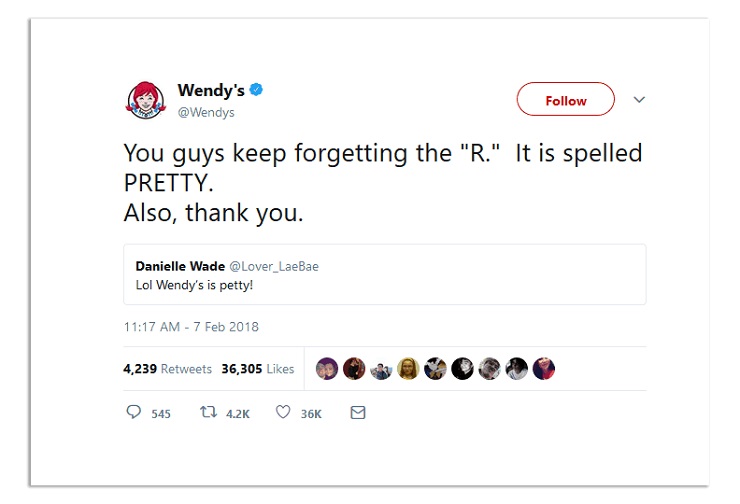
What happens if you don’t establish consistency in your brand’s voice and tone?
Leaving this part of your marketing to chance brings about all sorts of unsavory backlash. Without establishing your brand’s voice and tone, your marketing can easily come across as inauthentic.
Your customers are forming opinions of you every single time they interact with your brand. Poor voice and tone can destroy otherwise great marketing intentions and make your campaigns totally tone-deaf. And by then, the bad press for your brand is already out there, and it’s hard to recover. You’re missing vital relationship opportunities. That sucks.
The Brand Environment: Going Beyond Type, Color, and Logo
Next, let’s talk about the brand environment, what it is, and how it can make marketing fun rather than a complete time suck.
The visual brand basics are a must: logo, typography, and colors. But what’s beyond that? A branded visual environment is the general “creative sandbox” your brand will play in. It’s all about setting creative guidelines to help you stay on brand everywhere you go. A complete brand environment should give you the tools you need for everyday visuals while not limiting your creative growth.
A branded visual environment is a comprehensive guide that helps shape and navigate your brand’s visuals everywhere it shows up. It’s your playbook, full of general rules that strike a balance between focused and fun. It’s what you’d deliver to a new employee if they asked, “So, what’s your brand all about?”
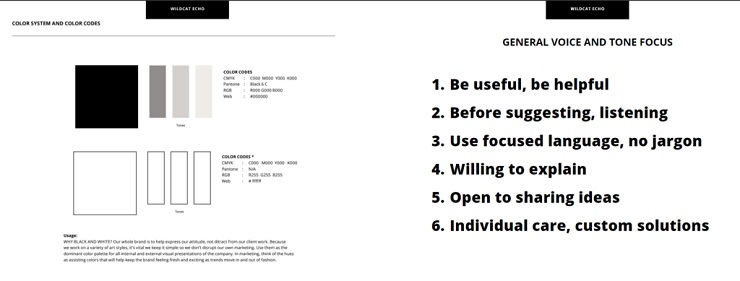
Creating a branded environment helps to inform your overall marketing plan. When you hire a photographer, what do you tell them? When you onboard a social media agency, do they know how to continue to tell your story visually?
Creating a Brand Environment is Not Difficult
This feels like a tough concept, and startup founders struggle to wrap their heads around it. But crafting an environment can be as simple or as complicated as you need it to be, depending on your goals and company size. As your company grows, so will your visual brand environment and its needs. The key is to start small and build as you grow.
To start you off, here are some questions to ask yourself:
- How do you make sure your brand visuals are consistent on every platform?
- How are you making sure your website graphics match the photos you use on Instagram?
- If you wanted to design a new email drip campaign, do you have enough visuals to pull it off right this second? Or would you be left staring at the screen feeling the pressure of a deadline?
You should be able to answer these questions by consulting your brand guidelines.
The Contents of Your Brand Environment
Every business, big or small, should have a brand guide that addresses how they want to curate their overall visuals and how they intend to stay “on brand.”
It informs everything from the stock photos you select, to the icons on your website, to the way you’re designing email newsletters.
Let’s show a real-world example of a brand we created for a local nonprofit. This flier is showing off a full brand environment in action, with a strong voice and tone in the copy and a unique visual layout.
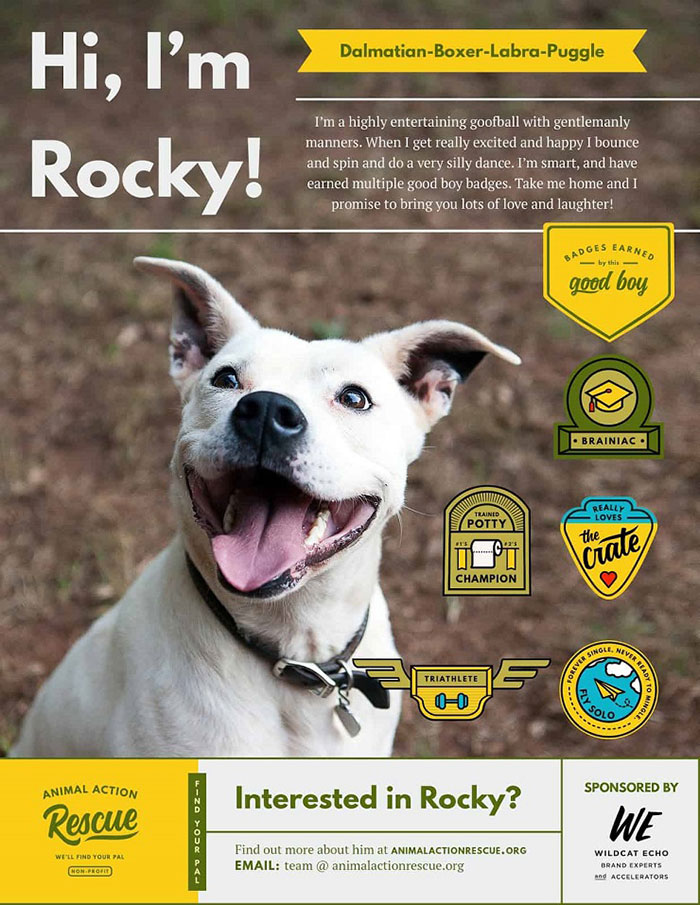
Note the design is more than just a brand’s colors and logo. It’s chock full of branded visuals that directly relate to treating the flier like a marketing campaign. This nonprofit wants to get this good boy adopted, so they’re using a custom photo of the pup, along with a consistent layout that feels related to the overall brand.
The voice and tone are cheery and upbeat, adhering to their internal brand guidelines. It features custom badges, showing the great selling points of the adoptable doggie. It’s clear, consistent, and interesting to look at (plus, cute dog!)
A brand environment should be instantly recognizable and stick out among your competitors. If the contact information fell off this flier, you’d still know what company it belonged to.
Where to Start
There are many ways to build consistency visually. It can be as simple as using a common color theme in all visuals (light and airy, moody, bright?). You can choose to go straight for stock photos or work hard to create all original images for your company. All your visuals can feature your brand’s mascot using your product, or focus on showing your product in the hands of real people.
However you decide to craft your visual environment will be up to your unique company, but you need to choose. Pick a direction.
Start by stepping back and comparing your marketing goals with what visuals you currently have. If you have a logo and color scheme, is it enough? How would you use them to design a flyer, a drip marketing campaign, or a website? Do you need more visuals? Or maybe a consistent layout? Do you need a standard copy created to help you speed the process up?
Make a list of needs—everything from graphic design to copywriting. Once you’ve put in the work to create your brand guideline, you can get to work growing your brand beyond its logo. Once you’ve done that, your creative sandbox will help you too.
Create Consistently Branded Content That’s Always Fresh
When you have a brand identity, you have the power to focus on consistency, not repetition. That’s an important distinction. Repetition = death.
We often find that startups push their logos into everything they post, hoping that will be enough to tie everything together. But is blasting out your logo actually telling your brand story? Are you growing your content in a branded way, writing authentic copy in blog posts or social media blurbs that reflect who you are? Or is it just visually yelling LOGO! over and over again with no real consistency beyond that?
Newer startups have a tendency to shy away from creating content that showcases their brand environments in marketing because they’re worried about creating these “branding rules” will stifle them.
But, how are you making sure your Instagram posts aren’t dramatically different than your other marketing, like, say, your website design? And how are you making sure your copy reflects your brand? Are your captions on social media wildly different than the copy on your website?
Not crafting a brand guide ultimately gives you an extremely short design leash, no tools to work with, and no purpose to guide you. It’s hard to keep it fresh and consistent when you’ve got nothing to design with and no way to measure success.
Often, it feels like too big of a cost sink to create new content and track its consistency all the time. But what’s more expensive? Losing customers because your environment is inconsistent, or doing the work needed to create an environment that builds loyalty and trust?
How to Do It
Brand consistency should be thought of as storytelling. How good of a storyteller is your brand? Does your content help tell your story? Just like a story, branded content needs to have a beginning, middle, and end. It can’t just be the same design repeated constantly. That feels stale, boring, unoriginal.
For one example of engaging, branded content, take Simone LeBlanc, a premier gift-giving company. When you land on their website, it’s clear why the company exists and what its values are, (to gift expertly, and thoughtfully).
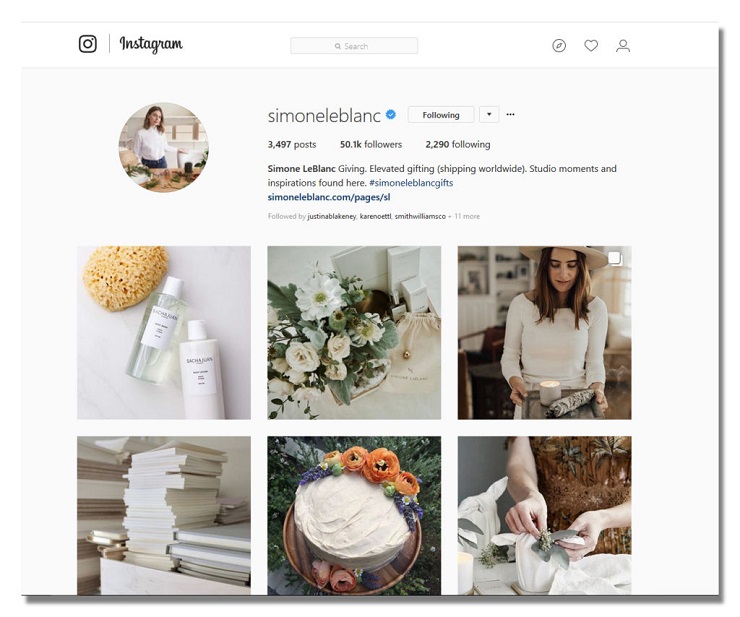
Their website copy, photography, and overall content are so high quality. When you move over to their Instagram, the feeling is the same. It’s seamless, and there’s no disruption in the overall marketing experience. Every email campaign is a delight, geared towards the best gift-giving practices. Their brand is sticky, keeping us around and coming back again and again. Their marketing is clear. It’s easy to fall in love with them.
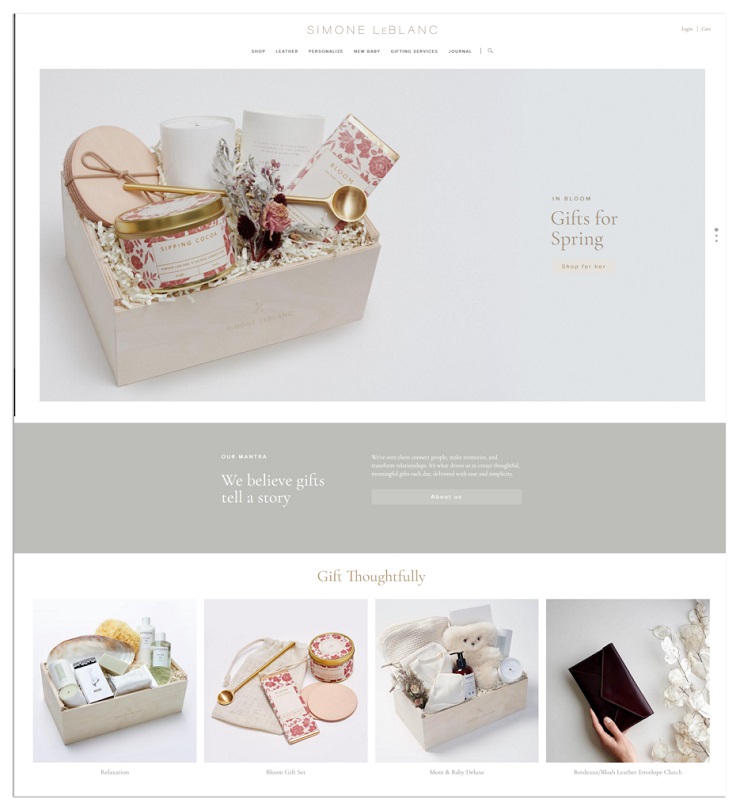
Having stale brand content typically walks hand and hand with only developing a logo and a few colors. Ignore that there are multiple ways to control your brand and you miss out on massive communications opportunities.
A Great Brand Identity System Precedes Great Marketing
Marketing is a breeze when you get your brand right from the start. That’s because your brand is the long-term marketing tool that shapes your day-to-day marketing activities.
Building a stronger brand should start with why you matter to customers, and build up to a larger visual and verbal brand environment to play with. It’s all about structure, consistency, and active ideation in order to grow your brand recognition in the way it matters most. When you build an arsenal of design, on-brand marketing messages, and actionable guidelines, crafting a marketing funnel becomes a breeze.
Whether you take control of your brand now or five years from now, your brand exists and affects your audience. It’s all a matter of whether you want to spend your time telling your customers what your brand is or have your customers tell you.
Take it from us, it’s much easier to influence an audience early on than it is to change an existing bad perception of you.
Take the time to shape your branding system. Future You will thank Past You for it, we promise.
Struggling with something related to brand growth? Pop a comment below
SOURCE: foundr.com










